Implementing and Monitoring WHS Policies - Public Health Assignment
VerifiedAdded on 2020/05/28
|33
|8620
|120
Homework Assignment
AI Summary
This assignment provides a comprehensive overview of implementing and monitoring Work Health and Safety (WHS) policies in Australian workplaces. It covers key provisions of WHS legislation, including managing risks, protecting workers from injury and illness (including psychological injury), and ensuring public health and safety. The assignment delves into the specifics of identifying hazards, conducting risk assessments, and implementing control measures. It also examines WHS codes of practice, outlining compliance requirements, practical advice for organizations, and effective risk management strategies. Furthermore, the assignment explores various organizational WHS policies, procedures, and programs, such as handling hazardous chemicals, managing alcohol and drug intoxication, consultative arrangements, emergency procedures, family-friendly workplace arrangements, first aid, hazard reporting, risk assessment and control processes, incident investigations, and work-life balance. The content is structured to provide a clear understanding of WHS principles and their practical application in maintaining a safe and healthy work environment.
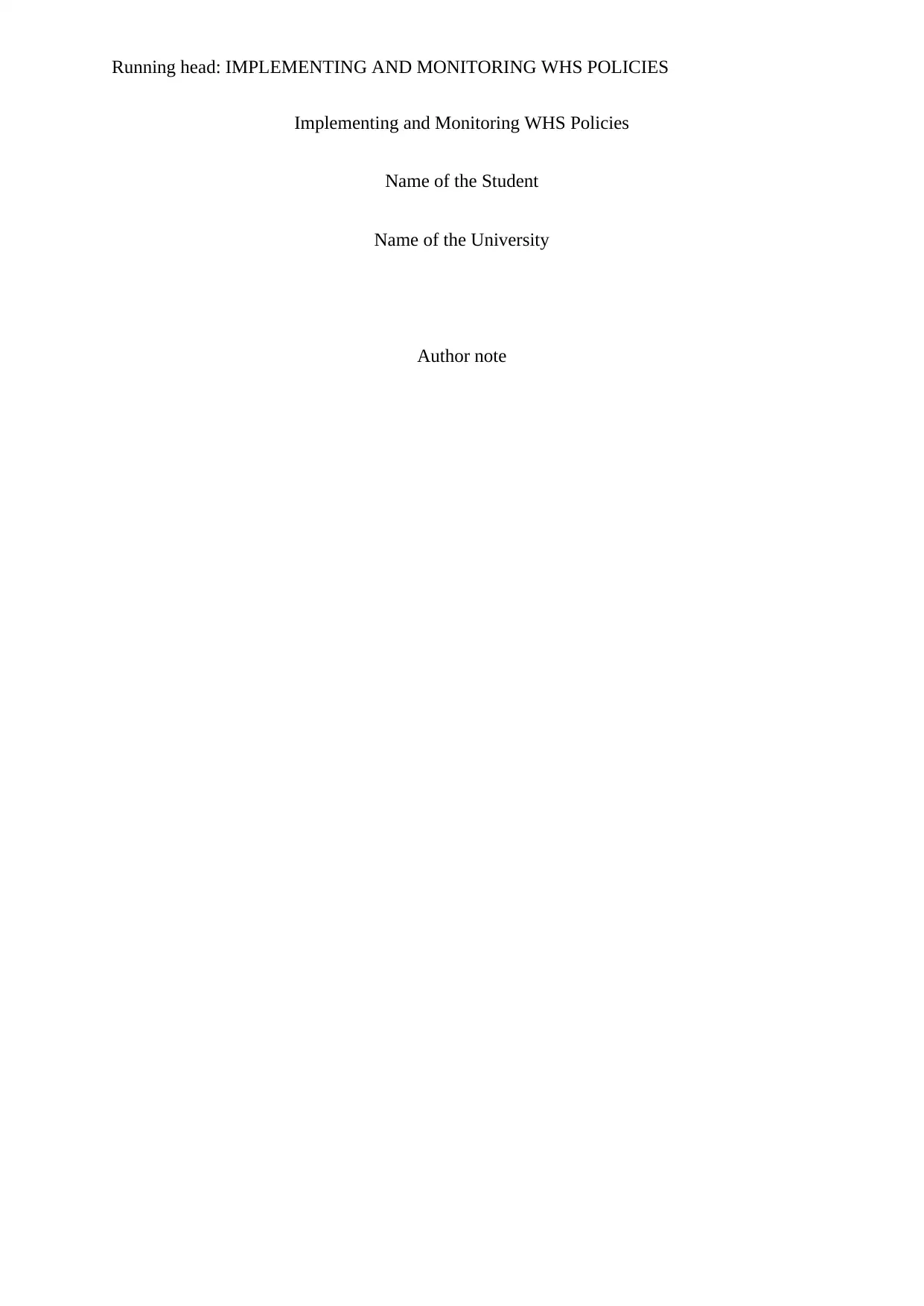
Running head: IMPLEMENTING AND MONITORING WHS POLICIES
Implementing and Monitoring WHS Policies
Name of the Student
Name of the University
Author note
Implementing and Monitoring WHS Policies
Name of the Student
Name of the University
Author note
Paraphrase This Document
Need a fresh take? Get an instant paraphrase of this document with our AI Paraphraser
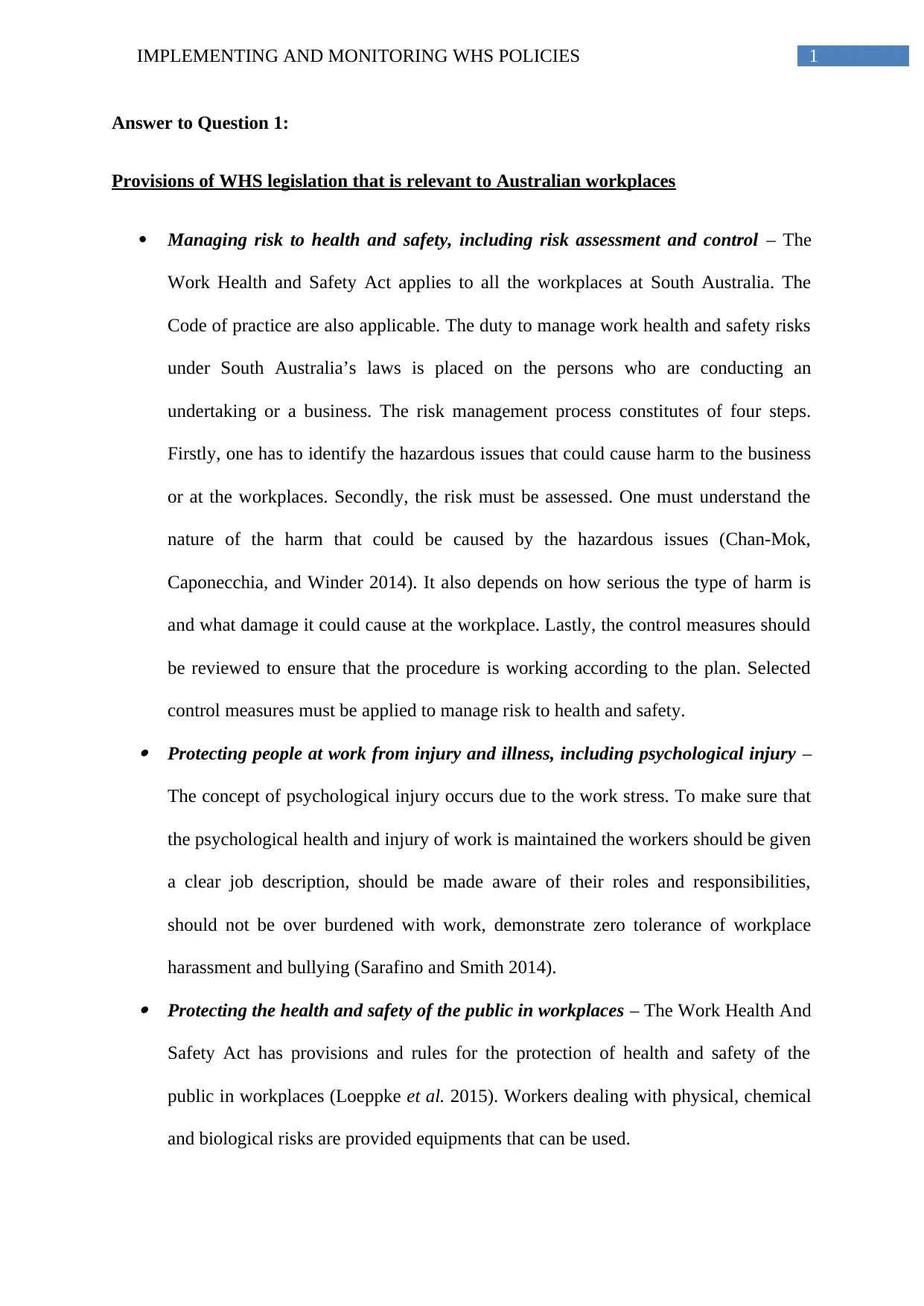
1IMPLEMENTING AND MONITORING WHS POLICIES
Answer to Question 1:
Provisions of WHS legislation that is relevant to Australian workplaces
Managing risk to health and safety, including risk assessment and control – The
Work Health and Safety Act applies to all the workplaces at South Australia. The
Code of practice are also applicable. The duty to manage work health and safety risks
under South Australia’s laws is placed on the persons who are conducting an
undertaking or a business. The risk management process constitutes of four steps.
Firstly, one has to identify the hazardous issues that could cause harm to the business
or at the workplaces. Secondly, the risk must be assessed. One must understand the
nature of the harm that could be caused by the hazardous issues (Chan-Mok,
Caponecchia, and Winder 2014). It also depends on how serious the type of harm is
and what damage it could cause at the workplace. Lastly, the control measures should
be reviewed to ensure that the procedure is working according to the plan. Selected
control measures must be applied to manage risk to health and safety. Protecting people at work from injury and illness, including psychological injury –
The concept of psychological injury occurs due to the work stress. To make sure that
the psychological health and injury of work is maintained the workers should be given
a clear job description, should be made aware of their roles and responsibilities,
should not be over burdened with work, demonstrate zero tolerance of workplace
harassment and bullying (Sarafino and Smith 2014). Protecting the health and safety of the public in workplaces – The Work Health And
Safety Act has provisions and rules for the protection of health and safety of the
public in workplaces (Loeppke et al. 2015). Workers dealing with physical, chemical
and biological risks are provided equipments that can be used.
Answer to Question 1:
Provisions of WHS legislation that is relevant to Australian workplaces
Managing risk to health and safety, including risk assessment and control – The
Work Health and Safety Act applies to all the workplaces at South Australia. The
Code of practice are also applicable. The duty to manage work health and safety risks
under South Australia’s laws is placed on the persons who are conducting an
undertaking or a business. The risk management process constitutes of four steps.
Firstly, one has to identify the hazardous issues that could cause harm to the business
or at the workplaces. Secondly, the risk must be assessed. One must understand the
nature of the harm that could be caused by the hazardous issues (Chan-Mok,
Caponecchia, and Winder 2014). It also depends on how serious the type of harm is
and what damage it could cause at the workplace. Lastly, the control measures should
be reviewed to ensure that the procedure is working according to the plan. Selected
control measures must be applied to manage risk to health and safety. Protecting people at work from injury and illness, including psychological injury –
The concept of psychological injury occurs due to the work stress. To make sure that
the psychological health and injury of work is maintained the workers should be given
a clear job description, should be made aware of their roles and responsibilities,
should not be over burdened with work, demonstrate zero tolerance of workplace
harassment and bullying (Sarafino and Smith 2014). Protecting the health and safety of the public in workplaces – The Work Health And
Safety Act has provisions and rules for the protection of health and safety of the
public in workplaces (Loeppke et al. 2015). Workers dealing with physical, chemical
and biological risks are provided equipments that can be used.
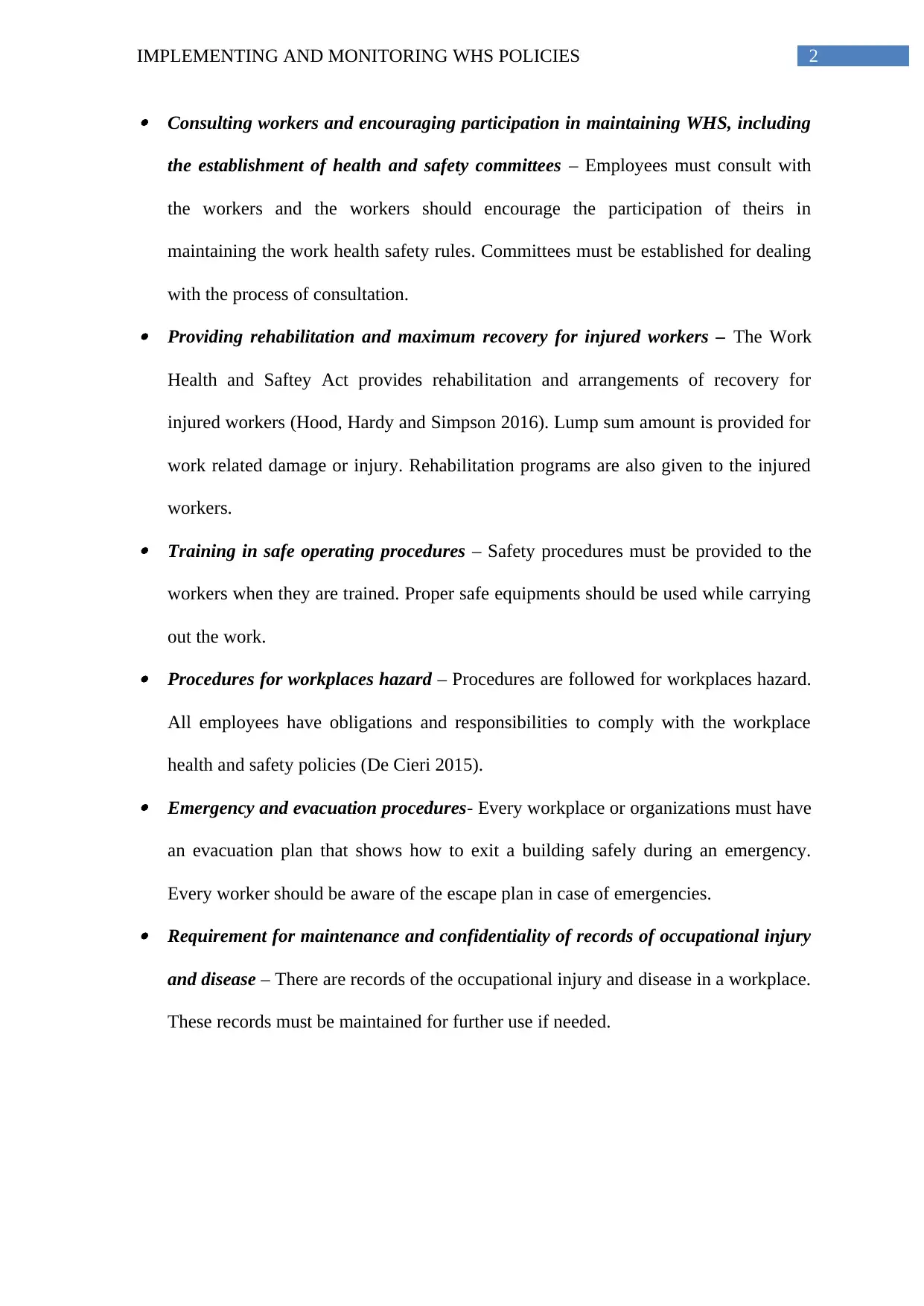
2IMPLEMENTING AND MONITORING WHS POLICIES
Consulting workers and encouraging participation in maintaining WHS, including
the establishment of health and safety committees – Employees must consult with
the workers and the workers should encourage the participation of theirs in
maintaining the work health safety rules. Committees must be established for dealing
with the process of consultation. Providing rehabilitation and maximum recovery for injured workers – The Work
Health and Saftey Act provides rehabilitation and arrangements of recovery for
injured workers (Hood, Hardy and Simpson 2016). Lump sum amount is provided for
work related damage or injury. Rehabilitation programs are also given to the injured
workers. Training in safe operating procedures – Safety procedures must be provided to the
workers when they are trained. Proper safe equipments should be used while carrying
out the work. Procedures for workplaces hazard – Procedures are followed for workplaces hazard.
All employees have obligations and responsibilities to comply with the workplace
health and safety policies (De Cieri 2015). Emergency and evacuation procedures- Every workplace or organizations must have
an evacuation plan that shows how to exit a building safely during an emergency.
Every worker should be aware of the escape plan in case of emergencies. Requirement for maintenance and confidentiality of records of occupational injury
and disease – There are records of the occupational injury and disease in a workplace.
These records must be maintained for further use if needed.
Consulting workers and encouraging participation in maintaining WHS, including
the establishment of health and safety committees – Employees must consult with
the workers and the workers should encourage the participation of theirs in
maintaining the work health safety rules. Committees must be established for dealing
with the process of consultation. Providing rehabilitation and maximum recovery for injured workers – The Work
Health and Saftey Act provides rehabilitation and arrangements of recovery for
injured workers (Hood, Hardy and Simpson 2016). Lump sum amount is provided for
work related damage or injury. Rehabilitation programs are also given to the injured
workers. Training in safe operating procedures – Safety procedures must be provided to the
workers when they are trained. Proper safe equipments should be used while carrying
out the work. Procedures for workplaces hazard – Procedures are followed for workplaces hazard.
All employees have obligations and responsibilities to comply with the workplace
health and safety policies (De Cieri 2015). Emergency and evacuation procedures- Every workplace or organizations must have
an evacuation plan that shows how to exit a building safely during an emergency.
Every worker should be aware of the escape plan in case of emergencies. Requirement for maintenance and confidentiality of records of occupational injury
and disease – There are records of the occupational injury and disease in a workplace.
These records must be maintained for further use if needed.
⊘ This is a preview!⊘
Do you want full access?
Subscribe today to unlock all pages.

Trusted by 1+ million students worldwide
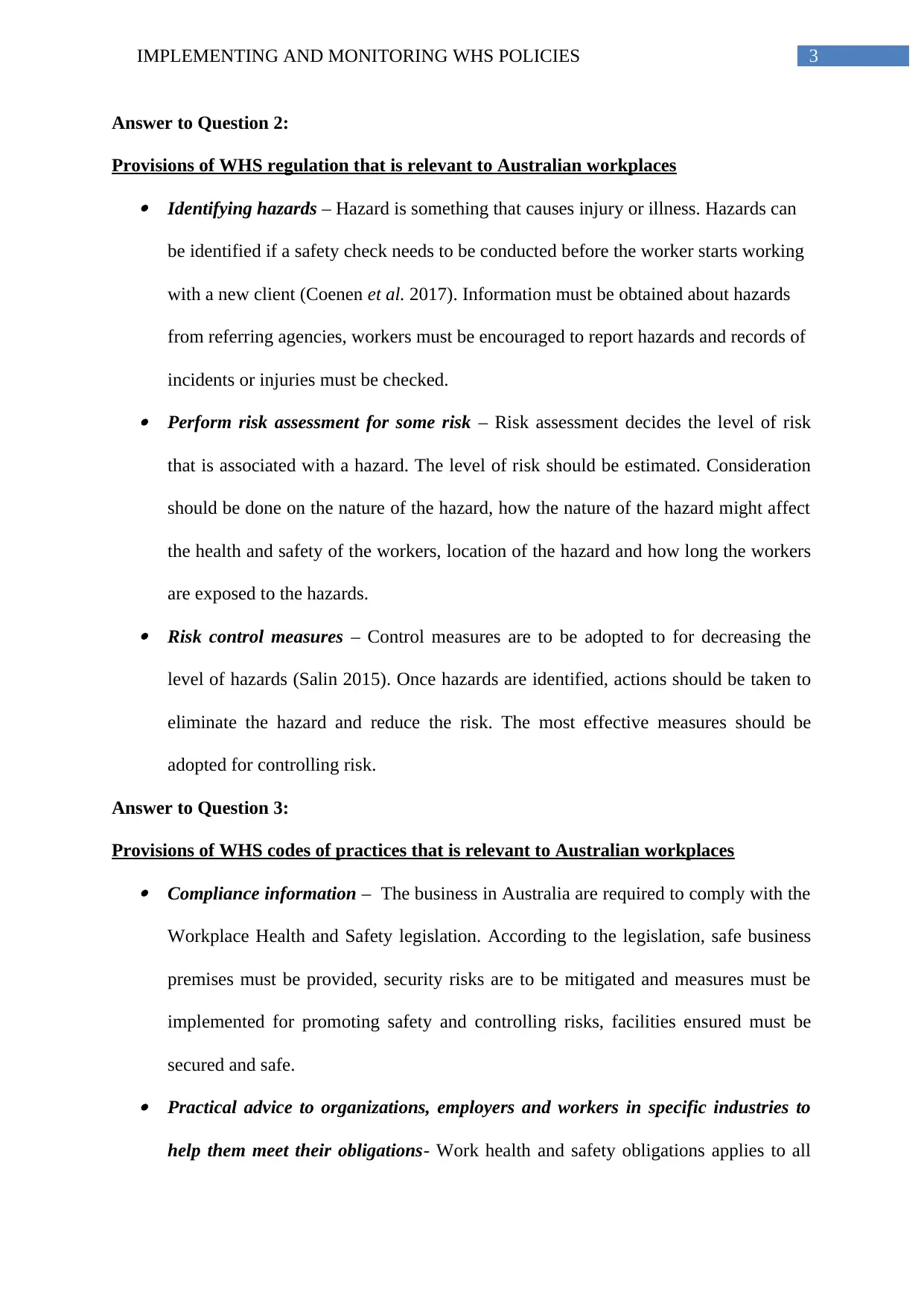
3IMPLEMENTING AND MONITORING WHS POLICIES
Answer to Question 2:
Provisions of WHS regulation that is relevant to Australian workplaces Identifying hazards – Hazard is something that causes injury or illness. Hazards can
be identified if a safety check needs to be conducted before the worker starts working
with a new client (Coenen et al. 2017). Information must be obtained about hazards
from referring agencies, workers must be encouraged to report hazards and records of
incidents or injuries must be checked. Perform risk assessment for some risk – Risk assessment decides the level of risk
that is associated with a hazard. The level of risk should be estimated. Consideration
should be done on the nature of the hazard, how the nature of the hazard might affect
the health and safety of the workers, location of the hazard and how long the workers
are exposed to the hazards. Risk control measures – Control measures are to be adopted to for decreasing the
level of hazards (Salin 2015). Once hazards are identified, actions should be taken to
eliminate the hazard and reduce the risk. The most effective measures should be
adopted for controlling risk.
Answer to Question 3:
Provisions of WHS codes of practices that is relevant to Australian workplaces Compliance information – The business in Australia are required to comply with the
Workplace Health and Safety legislation. According to the legislation, safe business
premises must be provided, security risks are to be mitigated and measures must be
implemented for promoting safety and controlling risks, facilities ensured must be
secured and safe. Practical advice to organizations, employers and workers in specific industries to
help them meet their obligations- Work health and safety obligations applies to all
Answer to Question 2:
Provisions of WHS regulation that is relevant to Australian workplaces Identifying hazards – Hazard is something that causes injury or illness. Hazards can
be identified if a safety check needs to be conducted before the worker starts working
with a new client (Coenen et al. 2017). Information must be obtained about hazards
from referring agencies, workers must be encouraged to report hazards and records of
incidents or injuries must be checked. Perform risk assessment for some risk – Risk assessment decides the level of risk
that is associated with a hazard. The level of risk should be estimated. Consideration
should be done on the nature of the hazard, how the nature of the hazard might affect
the health and safety of the workers, location of the hazard and how long the workers
are exposed to the hazards. Risk control measures – Control measures are to be adopted to for decreasing the
level of hazards (Salin 2015). Once hazards are identified, actions should be taken to
eliminate the hazard and reduce the risk. The most effective measures should be
adopted for controlling risk.
Answer to Question 3:
Provisions of WHS codes of practices that is relevant to Australian workplaces Compliance information – The business in Australia are required to comply with the
Workplace Health and Safety legislation. According to the legislation, safe business
premises must be provided, security risks are to be mitigated and measures must be
implemented for promoting safety and controlling risks, facilities ensured must be
secured and safe. Practical advice to organizations, employers and workers in specific industries to
help them meet their obligations- Work health and safety obligations applies to all
Paraphrase This Document
Need a fresh take? Get an instant paraphrase of this document with our AI Paraphraser
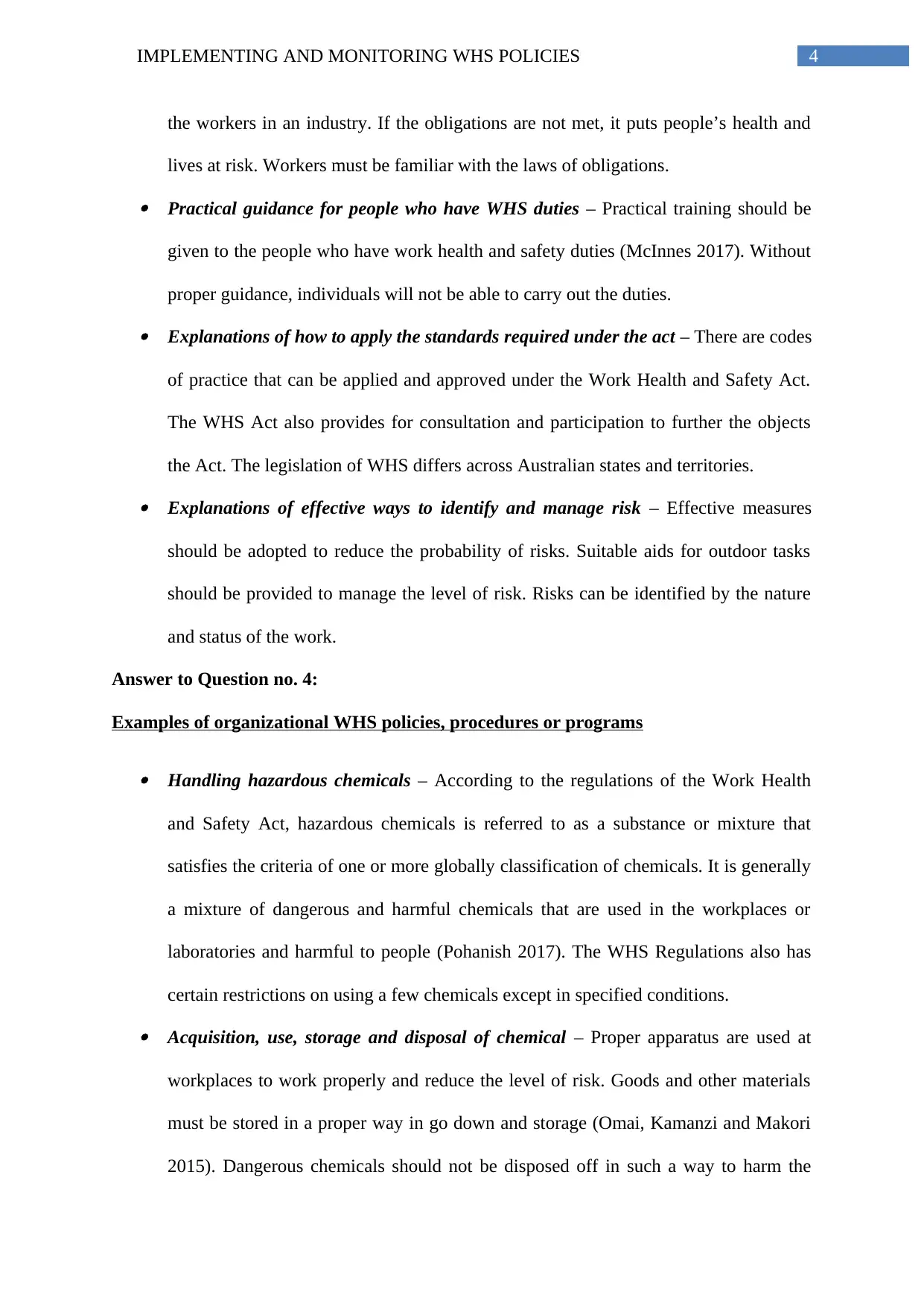
4IMPLEMENTING AND MONITORING WHS POLICIES
the workers in an industry. If the obligations are not met, it puts people’s health and
lives at risk. Workers must be familiar with the laws of obligations. Practical guidance for people who have WHS duties – Practical training should be
given to the people who have work health and safety duties (McInnes 2017). Without
proper guidance, individuals will not be able to carry out the duties. Explanations of how to apply the standards required under the act – There are codes
of practice that can be applied and approved under the Work Health and Safety Act.
The WHS Act also provides for consultation and participation to further the objects
the Act. The legislation of WHS differs across Australian states and territories. Explanations of effective ways to identify and manage risk – Effective measures
should be adopted to reduce the probability of risks. Suitable aids for outdoor tasks
should be provided to manage the level of risk. Risks can be identified by the nature
and status of the work.
Answer to Question no. 4:
Examples of organizational WHS policies, procedures or programs
Handling hazardous chemicals – According to the regulations of the Work Health
and Safety Act, hazardous chemicals is referred to as a substance or mixture that
satisfies the criteria of one or more globally classification of chemicals. It is generally
a mixture of dangerous and harmful chemicals that are used in the workplaces or
laboratories and harmful to people (Pohanish 2017). The WHS Regulations also has
certain restrictions on using a few chemicals except in specified conditions. Acquisition, use, storage and disposal of chemical – Proper apparatus are used at
workplaces to work properly and reduce the level of risk. Goods and other materials
must be stored in a proper way in go down and storage (Omai, Kamanzi and Makori
2015). Dangerous chemicals should not be disposed off in such a way to harm the
the workers in an industry. If the obligations are not met, it puts people’s health and
lives at risk. Workers must be familiar with the laws of obligations. Practical guidance for people who have WHS duties – Practical training should be
given to the people who have work health and safety duties (McInnes 2017). Without
proper guidance, individuals will not be able to carry out the duties. Explanations of how to apply the standards required under the act – There are codes
of practice that can be applied and approved under the Work Health and Safety Act.
The WHS Act also provides for consultation and participation to further the objects
the Act. The legislation of WHS differs across Australian states and territories. Explanations of effective ways to identify and manage risk – Effective measures
should be adopted to reduce the probability of risks. Suitable aids for outdoor tasks
should be provided to manage the level of risk. Risks can be identified by the nature
and status of the work.
Answer to Question no. 4:
Examples of organizational WHS policies, procedures or programs
Handling hazardous chemicals – According to the regulations of the Work Health
and Safety Act, hazardous chemicals is referred to as a substance or mixture that
satisfies the criteria of one or more globally classification of chemicals. It is generally
a mixture of dangerous and harmful chemicals that are used in the workplaces or
laboratories and harmful to people (Pohanish 2017). The WHS Regulations also has
certain restrictions on using a few chemicals except in specified conditions. Acquisition, use, storage and disposal of chemical – Proper apparatus are used at
workplaces to work properly and reduce the level of risk. Goods and other materials
must be stored in a proper way in go down and storage (Omai, Kamanzi and Makori
2015). Dangerous chemicals should not be disposed off in such a way to harm the
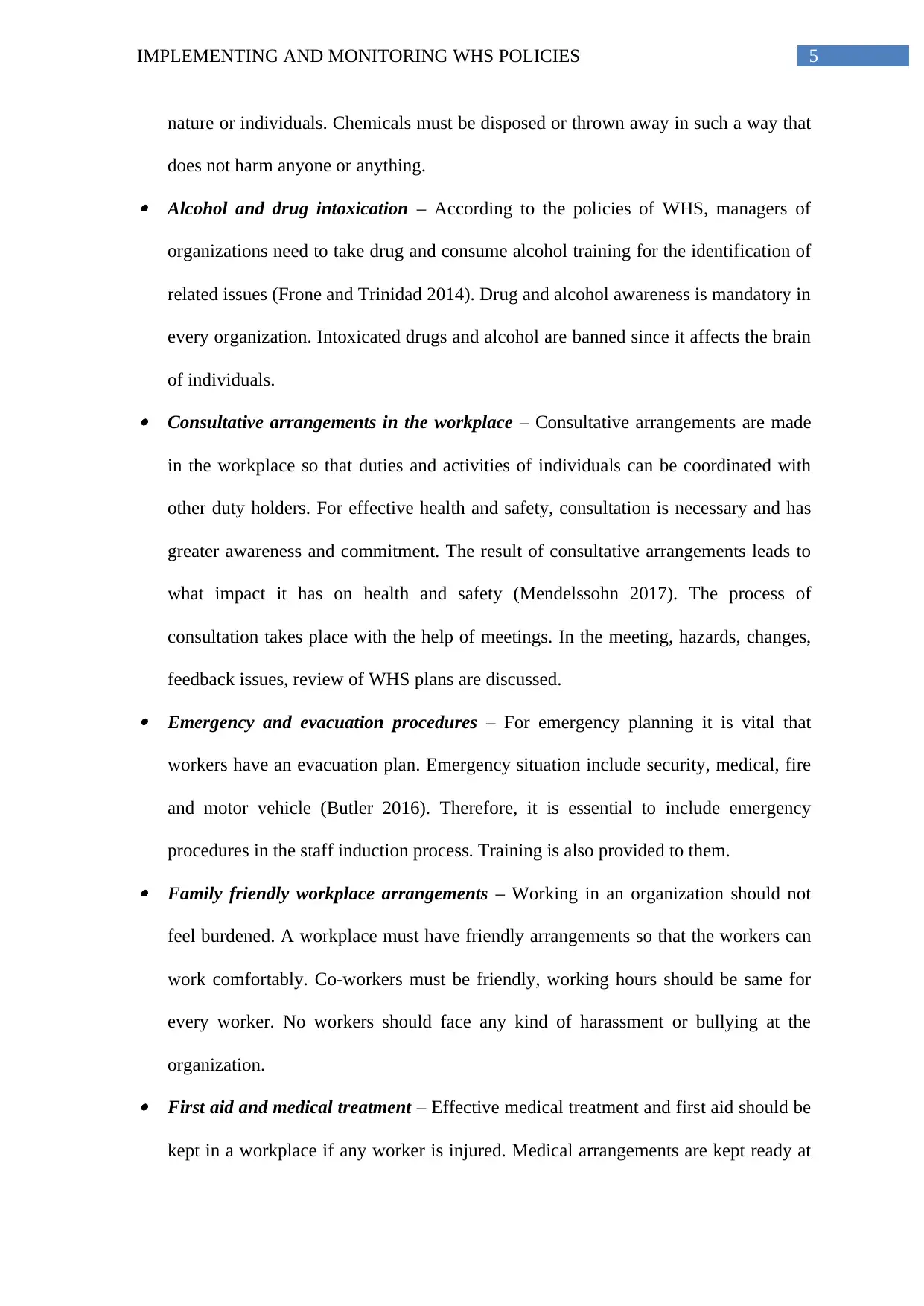
5IMPLEMENTING AND MONITORING WHS POLICIES
nature or individuals. Chemicals must be disposed or thrown away in such a way that
does not harm anyone or anything. Alcohol and drug intoxication – According to the policies of WHS, managers of
organizations need to take drug and consume alcohol training for the identification of
related issues (Frone and Trinidad 2014). Drug and alcohol awareness is mandatory in
every organization. Intoxicated drugs and alcohol are banned since it affects the brain
of individuals. Consultative arrangements in the workplace – Consultative arrangements are made
in the workplace so that duties and activities of individuals can be coordinated with
other duty holders. For effective health and safety, consultation is necessary and has
greater awareness and commitment. The result of consultative arrangements leads to
what impact it has on health and safety (Mendelssohn 2017). The process of
consultation takes place with the help of meetings. In the meeting, hazards, changes,
feedback issues, review of WHS plans are discussed. Emergency and evacuation procedures – For emergency planning it is vital that
workers have an evacuation plan. Emergency situation include security, medical, fire
and motor vehicle (Butler 2016). Therefore, it is essential to include emergency
procedures in the staff induction process. Training is also provided to them. Family friendly workplace arrangements – Working in an organization should not
feel burdened. A workplace must have friendly arrangements so that the workers can
work comfortably. Co-workers must be friendly, working hours should be same for
every worker. No workers should face any kind of harassment or bullying at the
organization. First aid and medical treatment – Effective medical treatment and first aid should be
kept in a workplace if any worker is injured. Medical arrangements are kept ready at
nature or individuals. Chemicals must be disposed or thrown away in such a way that
does not harm anyone or anything. Alcohol and drug intoxication – According to the policies of WHS, managers of
organizations need to take drug and consume alcohol training for the identification of
related issues (Frone and Trinidad 2014). Drug and alcohol awareness is mandatory in
every organization. Intoxicated drugs and alcohol are banned since it affects the brain
of individuals. Consultative arrangements in the workplace – Consultative arrangements are made
in the workplace so that duties and activities of individuals can be coordinated with
other duty holders. For effective health and safety, consultation is necessary and has
greater awareness and commitment. The result of consultative arrangements leads to
what impact it has on health and safety (Mendelssohn 2017). The process of
consultation takes place with the help of meetings. In the meeting, hazards, changes,
feedback issues, review of WHS plans are discussed. Emergency and evacuation procedures – For emergency planning it is vital that
workers have an evacuation plan. Emergency situation include security, medical, fire
and motor vehicle (Butler 2016). Therefore, it is essential to include emergency
procedures in the staff induction process. Training is also provided to them. Family friendly workplace arrangements – Working in an organization should not
feel burdened. A workplace must have friendly arrangements so that the workers can
work comfortably. Co-workers must be friendly, working hours should be same for
every worker. No workers should face any kind of harassment or bullying at the
organization. First aid and medical treatment – Effective medical treatment and first aid should be
kept in a workplace if any worker is injured. Medical arrangements are kept ready at
⊘ This is a preview!⊘
Do you want full access?
Subscribe today to unlock all pages.

Trusted by 1+ million students worldwide
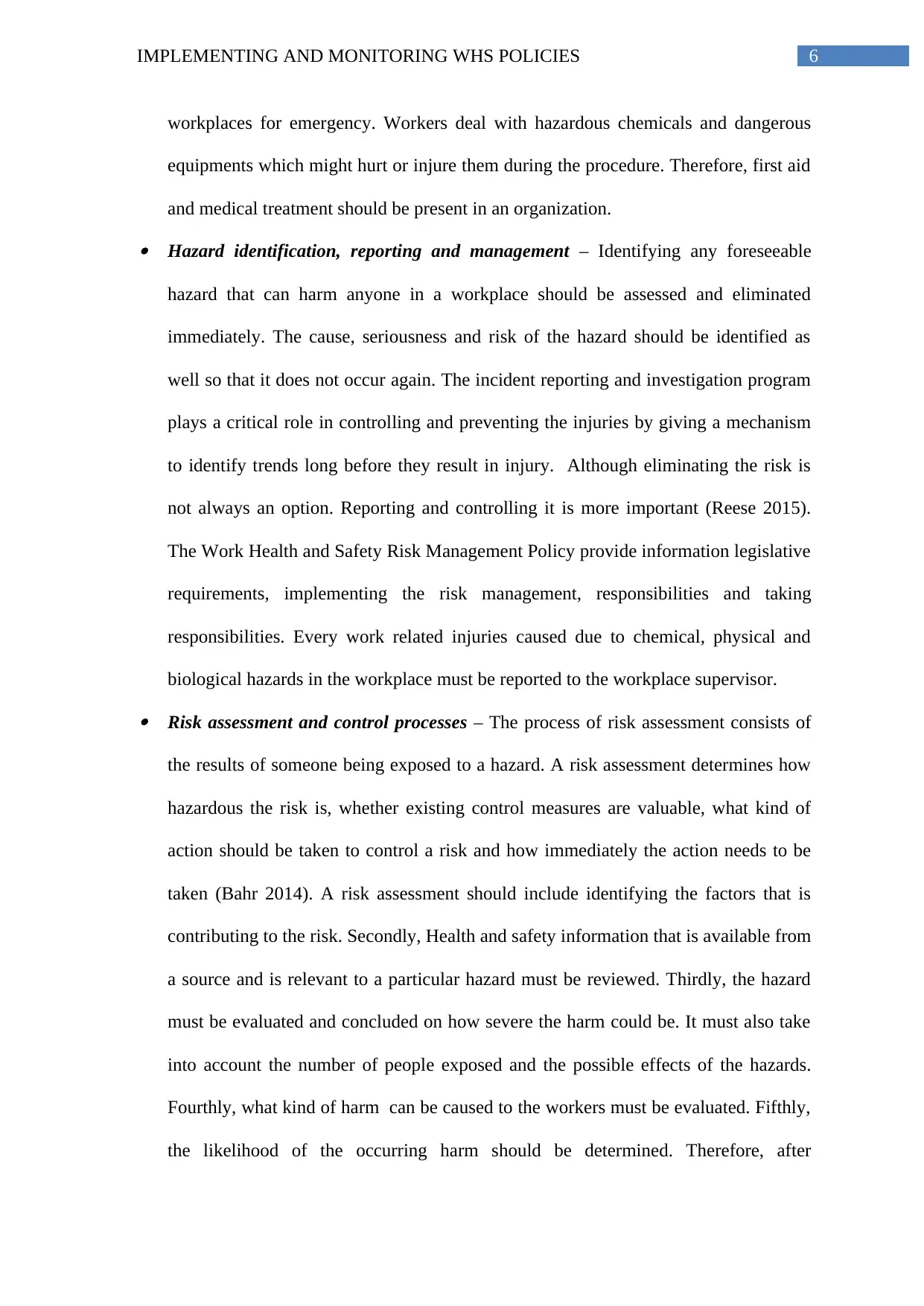
6IMPLEMENTING AND MONITORING WHS POLICIES
workplaces for emergency. Workers deal with hazardous chemicals and dangerous
equipments which might hurt or injure them during the procedure. Therefore, first aid
and medical treatment should be present in an organization. Hazard identification, reporting and management – Identifying any foreseeable
hazard that can harm anyone in a workplace should be assessed and eliminated
immediately. The cause, seriousness and risk of the hazard should be identified as
well so that it does not occur again. The incident reporting and investigation program
plays a critical role in controlling and preventing the injuries by giving a mechanism
to identify trends long before they result in injury. Although eliminating the risk is
not always an option. Reporting and controlling it is more important (Reese 2015).
The Work Health and Safety Risk Management Policy provide information legislative
requirements, implementing the risk management, responsibilities and taking
responsibilities. Every work related injuries caused due to chemical, physical and
biological hazards in the workplace must be reported to the workplace supervisor. Risk assessment and control processes – The process of risk assessment consists of
the results of someone being exposed to a hazard. A risk assessment determines how
hazardous the risk is, whether existing control measures are valuable, what kind of
action should be taken to control a risk and how immediately the action needs to be
taken (Bahr 2014). A risk assessment should include identifying the factors that is
contributing to the risk. Secondly, Health and safety information that is available from
a source and is relevant to a particular hazard must be reviewed. Thirdly, the hazard
must be evaluated and concluded on how severe the harm could be. It must also take
into account the number of people exposed and the possible effects of the hazards.
Fourthly, what kind of harm can be caused to the workers must be evaluated. Fifthly,
the likelihood of the occurring harm should be determined. Therefore, after
workplaces for emergency. Workers deal with hazardous chemicals and dangerous
equipments which might hurt or injure them during the procedure. Therefore, first aid
and medical treatment should be present in an organization. Hazard identification, reporting and management – Identifying any foreseeable
hazard that can harm anyone in a workplace should be assessed and eliminated
immediately. The cause, seriousness and risk of the hazard should be identified as
well so that it does not occur again. The incident reporting and investigation program
plays a critical role in controlling and preventing the injuries by giving a mechanism
to identify trends long before they result in injury. Although eliminating the risk is
not always an option. Reporting and controlling it is more important (Reese 2015).
The Work Health and Safety Risk Management Policy provide information legislative
requirements, implementing the risk management, responsibilities and taking
responsibilities. Every work related injuries caused due to chemical, physical and
biological hazards in the workplace must be reported to the workplace supervisor. Risk assessment and control processes – The process of risk assessment consists of
the results of someone being exposed to a hazard. A risk assessment determines how
hazardous the risk is, whether existing control measures are valuable, what kind of
action should be taken to control a risk and how immediately the action needs to be
taken (Bahr 2014). A risk assessment should include identifying the factors that is
contributing to the risk. Secondly, Health and safety information that is available from
a source and is relevant to a particular hazard must be reviewed. Thirdly, the hazard
must be evaluated and concluded on how severe the harm could be. It must also take
into account the number of people exposed and the possible effects of the hazards.
Fourthly, what kind of harm can be caused to the workers must be evaluated. Fifthly,
the likelihood of the occurring harm should be determined. Therefore, after
Paraphrase This Document
Need a fresh take? Get an instant paraphrase of this document with our AI Paraphraser
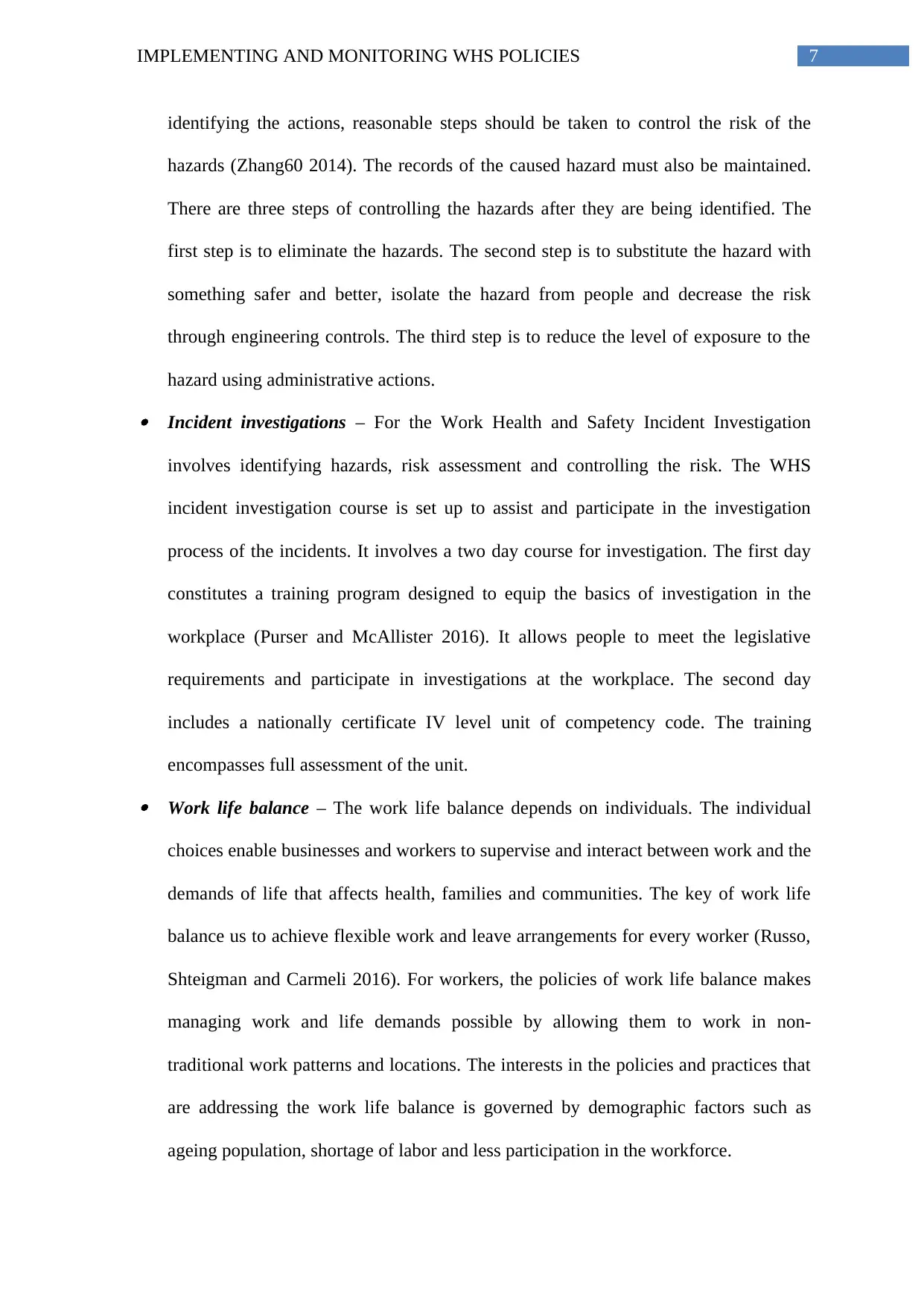
7IMPLEMENTING AND MONITORING WHS POLICIES
identifying the actions, reasonable steps should be taken to control the risk of the
hazards (Zhang60 2014). The records of the caused hazard must also be maintained.
There are three steps of controlling the hazards after they are being identified. The
first step is to eliminate the hazards. The second step is to substitute the hazard with
something safer and better, isolate the hazard from people and decrease the risk
through engineering controls. The third step is to reduce the level of exposure to the
hazard using administrative actions. Incident investigations – For the Work Health and Safety Incident Investigation
involves identifying hazards, risk assessment and controlling the risk. The WHS
incident investigation course is set up to assist and participate in the investigation
process of the incidents. It involves a two day course for investigation. The first day
constitutes a training program designed to equip the basics of investigation in the
workplace (Purser and McAllister 2016). It allows people to meet the legislative
requirements and participate in investigations at the workplace. The second day
includes a nationally certificate IV level unit of competency code. The training
encompasses full assessment of the unit. Work life balance – The work life balance depends on individuals. The individual
choices enable businesses and workers to supervise and interact between work and the
demands of life that affects health, families and communities. The key of work life
balance us to achieve flexible work and leave arrangements for every worker (Russo,
Shteigman and Carmeli 2016). For workers, the policies of work life balance makes
managing work and life demands possible by allowing them to work in non-
traditional work patterns and locations. The interests in the policies and practices that
are addressing the work life balance is governed by demographic factors such as
ageing population, shortage of labor and less participation in the workforce.
identifying the actions, reasonable steps should be taken to control the risk of the
hazards (Zhang60 2014). The records of the caused hazard must also be maintained.
There are three steps of controlling the hazards after they are being identified. The
first step is to eliminate the hazards. The second step is to substitute the hazard with
something safer and better, isolate the hazard from people and decrease the risk
through engineering controls. The third step is to reduce the level of exposure to the
hazard using administrative actions. Incident investigations – For the Work Health and Safety Incident Investigation
involves identifying hazards, risk assessment and controlling the risk. The WHS
incident investigation course is set up to assist and participate in the investigation
process of the incidents. It involves a two day course for investigation. The first day
constitutes a training program designed to equip the basics of investigation in the
workplace (Purser and McAllister 2016). It allows people to meet the legislative
requirements and participate in investigations at the workplace. The second day
includes a nationally certificate IV level unit of competency code. The training
encompasses full assessment of the unit. Work life balance – The work life balance depends on individuals. The individual
choices enable businesses and workers to supervise and interact between work and the
demands of life that affects health, families and communities. The key of work life
balance us to achieve flexible work and leave arrangements for every worker (Russo,
Shteigman and Carmeli 2016). For workers, the policies of work life balance makes
managing work and life demands possible by allowing them to work in non-
traditional work patterns and locations. The interests in the policies and practices that
are addressing the work life balance is governed by demographic factors such as
ageing population, shortage of labor and less participation in the workforce.
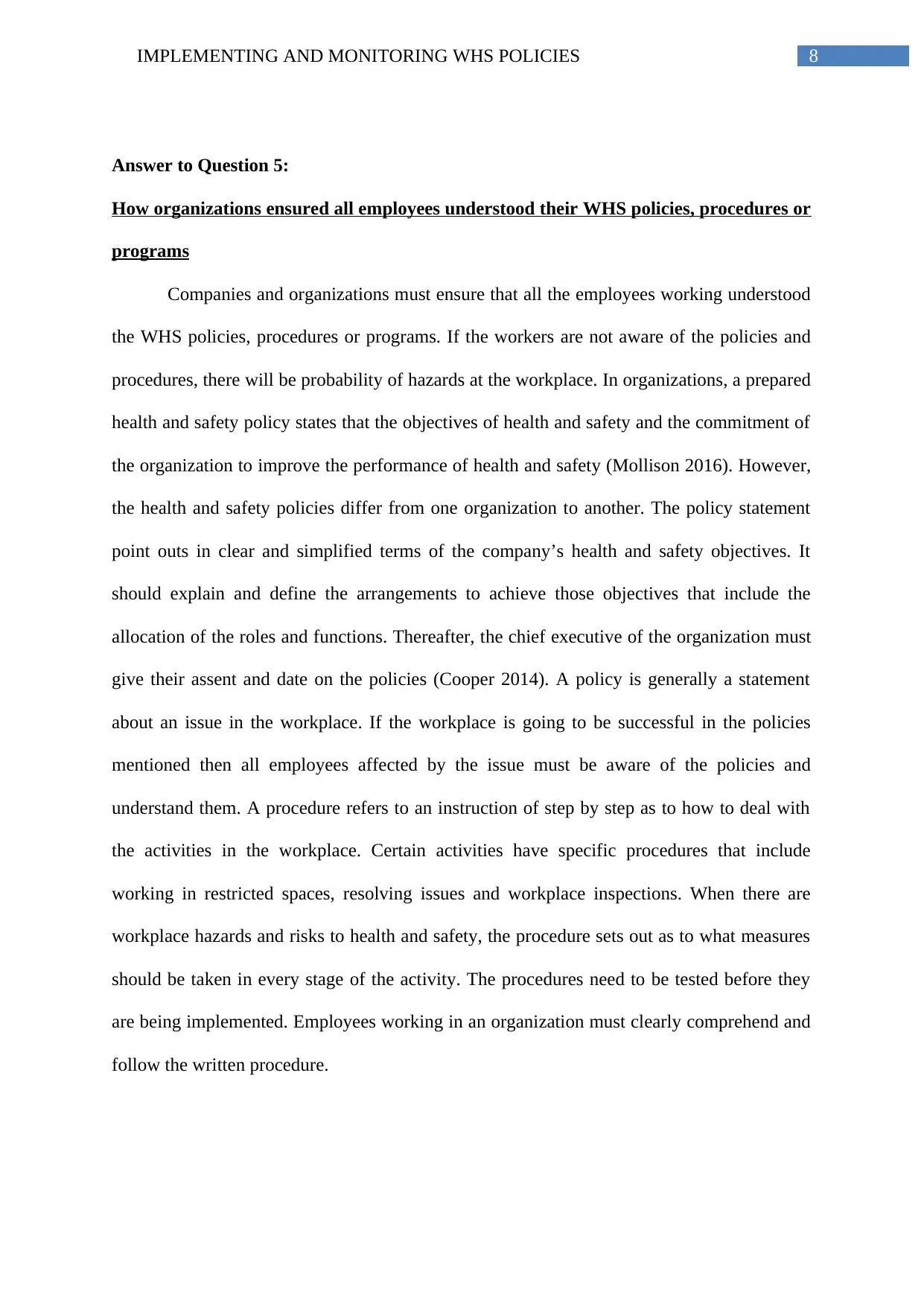
8IMPLEMENTING AND MONITORING WHS POLICIES
Answer to Question 5:
How organizations ensured all employees understood their WHS policies, procedures or
programs
Companies and organizations must ensure that all the employees working understood
the WHS policies, procedures or programs. If the workers are not aware of the policies and
procedures, there will be probability of hazards at the workplace. In organizations, a prepared
health and safety policy states that the objectives of health and safety and the commitment of
the organization to improve the performance of health and safety (Mollison 2016). However,
the health and safety policies differ from one organization to another. The policy statement
point outs in clear and simplified terms of the company’s health and safety objectives. It
should explain and define the arrangements to achieve those objectives that include the
allocation of the roles and functions. Thereafter, the chief executive of the organization must
give their assent and date on the policies (Cooper 2014). A policy is generally a statement
about an issue in the workplace. If the workplace is going to be successful in the policies
mentioned then all employees affected by the issue must be aware of the policies and
understand them. A procedure refers to an instruction of step by step as to how to deal with
the activities in the workplace. Certain activities have specific procedures that include
working in restricted spaces, resolving issues and workplace inspections. When there are
workplace hazards and risks to health and safety, the procedure sets out as to what measures
should be taken in every stage of the activity. The procedures need to be tested before they
are being implemented. Employees working in an organization must clearly comprehend and
follow the written procedure.
Answer to Question 5:
How organizations ensured all employees understood their WHS policies, procedures or
programs
Companies and organizations must ensure that all the employees working understood
the WHS policies, procedures or programs. If the workers are not aware of the policies and
procedures, there will be probability of hazards at the workplace. In organizations, a prepared
health and safety policy states that the objectives of health and safety and the commitment of
the organization to improve the performance of health and safety (Mollison 2016). However,
the health and safety policies differ from one organization to another. The policy statement
point outs in clear and simplified terms of the company’s health and safety objectives. It
should explain and define the arrangements to achieve those objectives that include the
allocation of the roles and functions. Thereafter, the chief executive of the organization must
give their assent and date on the policies (Cooper 2014). A policy is generally a statement
about an issue in the workplace. If the workplace is going to be successful in the policies
mentioned then all employees affected by the issue must be aware of the policies and
understand them. A procedure refers to an instruction of step by step as to how to deal with
the activities in the workplace. Certain activities have specific procedures that include
working in restricted spaces, resolving issues and workplace inspections. When there are
workplace hazards and risks to health and safety, the procedure sets out as to what measures
should be taken in every stage of the activity. The procedures need to be tested before they
are being implemented. Employees working in an organization must clearly comprehend and
follow the written procedure.
⊘ This is a preview!⊘
Do you want full access?
Subscribe today to unlock all pages.

Trusted by 1+ million students worldwide
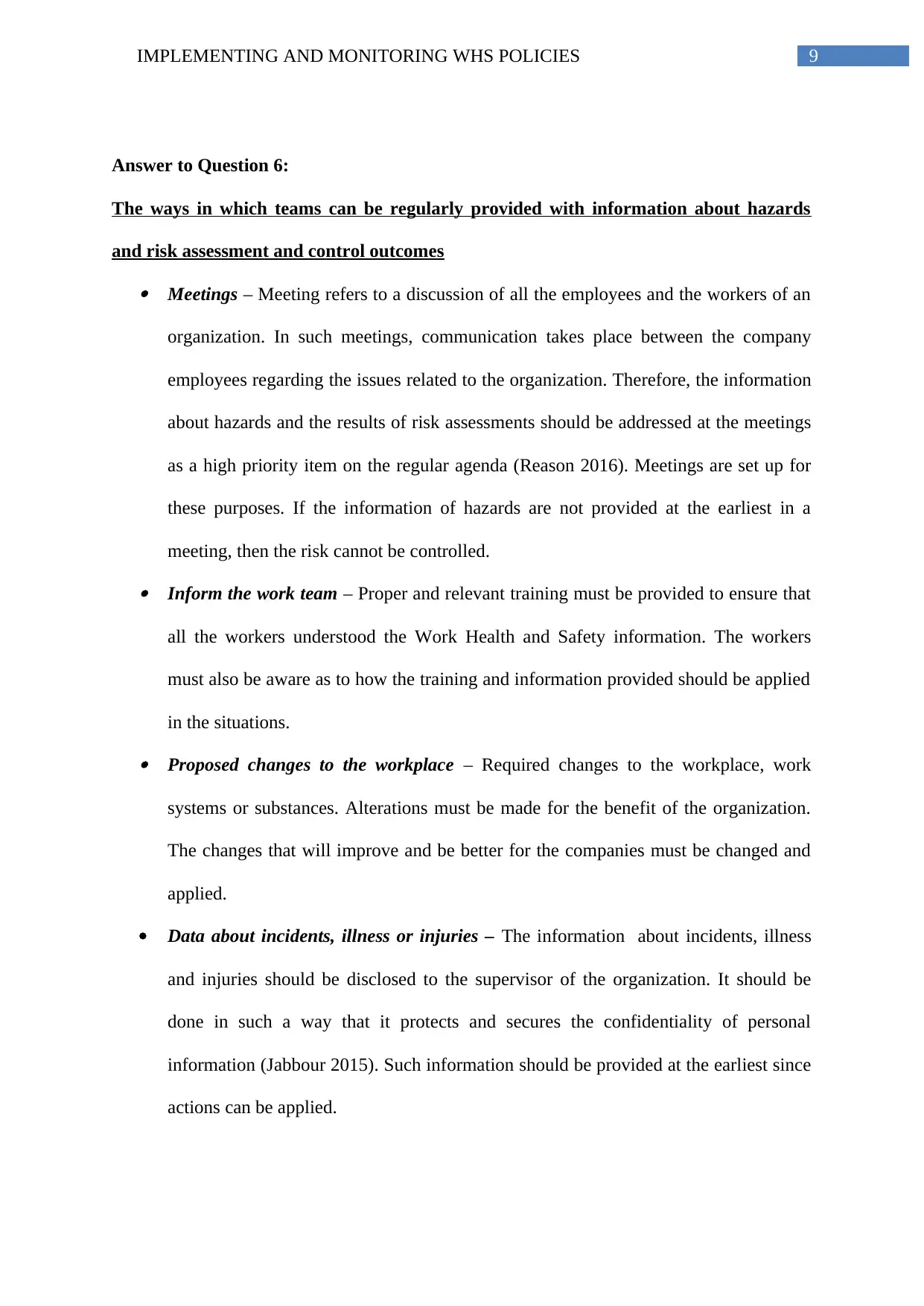
9IMPLEMENTING AND MONITORING WHS POLICIES
Answer to Question 6:
The ways in which teams can be regularly provided with information about hazards
and risk assessment and control outcomes Meetings – Meeting refers to a discussion of all the employees and the workers of an
organization. In such meetings, communication takes place between the company
employees regarding the issues related to the organization. Therefore, the information
about hazards and the results of risk assessments should be addressed at the meetings
as a high priority item on the regular agenda (Reason 2016). Meetings are set up for
these purposes. If the information of hazards are not provided at the earliest in a
meeting, then the risk cannot be controlled. Inform the work team – Proper and relevant training must be provided to ensure that
all the workers understood the Work Health and Safety information. The workers
must also be aware as to how the training and information provided should be applied
in the situations. Proposed changes to the workplace – Required changes to the workplace, work
systems or substances. Alterations must be made for the benefit of the organization.
The changes that will improve and be better for the companies must be changed and
applied.
Data about incidents, illness or injuries – The information about incidents, illness
and injuries should be disclosed to the supervisor of the organization. It should be
done in such a way that it protects and secures the confidentiality of personal
information (Jabbour 2015). Such information should be provided at the earliest since
actions can be applied.
Answer to Question 6:
The ways in which teams can be regularly provided with information about hazards
and risk assessment and control outcomes Meetings – Meeting refers to a discussion of all the employees and the workers of an
organization. In such meetings, communication takes place between the company
employees regarding the issues related to the organization. Therefore, the information
about hazards and the results of risk assessments should be addressed at the meetings
as a high priority item on the regular agenda (Reason 2016). Meetings are set up for
these purposes. If the information of hazards are not provided at the earliest in a
meeting, then the risk cannot be controlled. Inform the work team – Proper and relevant training must be provided to ensure that
all the workers understood the Work Health and Safety information. The workers
must also be aware as to how the training and information provided should be applied
in the situations. Proposed changes to the workplace – Required changes to the workplace, work
systems or substances. Alterations must be made for the benefit of the organization.
The changes that will improve and be better for the companies must be changed and
applied.
Data about incidents, illness or injuries – The information about incidents, illness
and injuries should be disclosed to the supervisor of the organization. It should be
done in such a way that it protects and secures the confidentiality of personal
information (Jabbour 2015). Such information should be provided at the earliest since
actions can be applied.
Paraphrase This Document
Need a fresh take? Get an instant paraphrase of this document with our AI Paraphraser
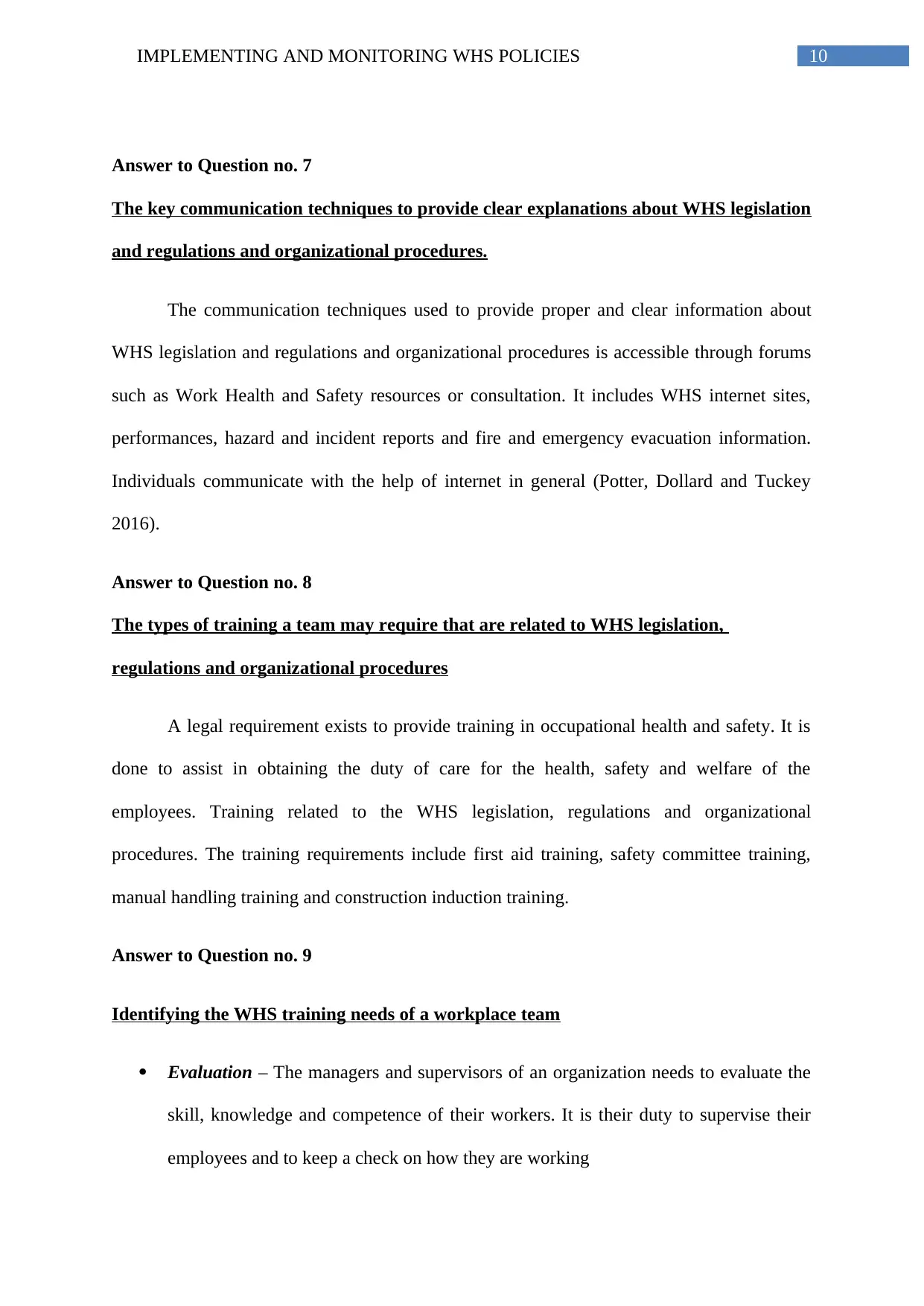
10IMPLEMENTING AND MONITORING WHS POLICIES
Answer to Question no. 7
The key communication techniques to provide clear explanations about WHS legislation
and regulations and organizational procedures.
The communication techniques used to provide proper and clear information about
WHS legislation and regulations and organizational procedures is accessible through forums
such as Work Health and Safety resources or consultation. It includes WHS internet sites,
performances, hazard and incident reports and fire and emergency evacuation information.
Individuals communicate with the help of internet in general (Potter, Dollard and Tuckey
2016).
Answer to Question no. 8
The types of training a team may require that are related to WHS legislation,
regulations and organizational procedures
A legal requirement exists to provide training in occupational health and safety. It is
done to assist in obtaining the duty of care for the health, safety and welfare of the
employees. Training related to the WHS legislation, regulations and organizational
procedures. The training requirements include first aid training, safety committee training,
manual handling training and construction induction training.
Answer to Question no. 9
Identifying the WHS training needs of a workplace team
Evaluation – The managers and supervisors of an organization needs to evaluate the
skill, knowledge and competence of their workers. It is their duty to supervise their
employees and to keep a check on how they are working
Answer to Question no. 7
The key communication techniques to provide clear explanations about WHS legislation
and regulations and organizational procedures.
The communication techniques used to provide proper and clear information about
WHS legislation and regulations and organizational procedures is accessible through forums
such as Work Health and Safety resources or consultation. It includes WHS internet sites,
performances, hazard and incident reports and fire and emergency evacuation information.
Individuals communicate with the help of internet in general (Potter, Dollard and Tuckey
2016).
Answer to Question no. 8
The types of training a team may require that are related to WHS legislation,
regulations and organizational procedures
A legal requirement exists to provide training in occupational health and safety. It is
done to assist in obtaining the duty of care for the health, safety and welfare of the
employees. Training related to the WHS legislation, regulations and organizational
procedures. The training requirements include first aid training, safety committee training,
manual handling training and construction induction training.
Answer to Question no. 9
Identifying the WHS training needs of a workplace team
Evaluation – The managers and supervisors of an organization needs to evaluate the
skill, knowledge and competence of their workers. It is their duty to supervise their
employees and to keep a check on how they are working
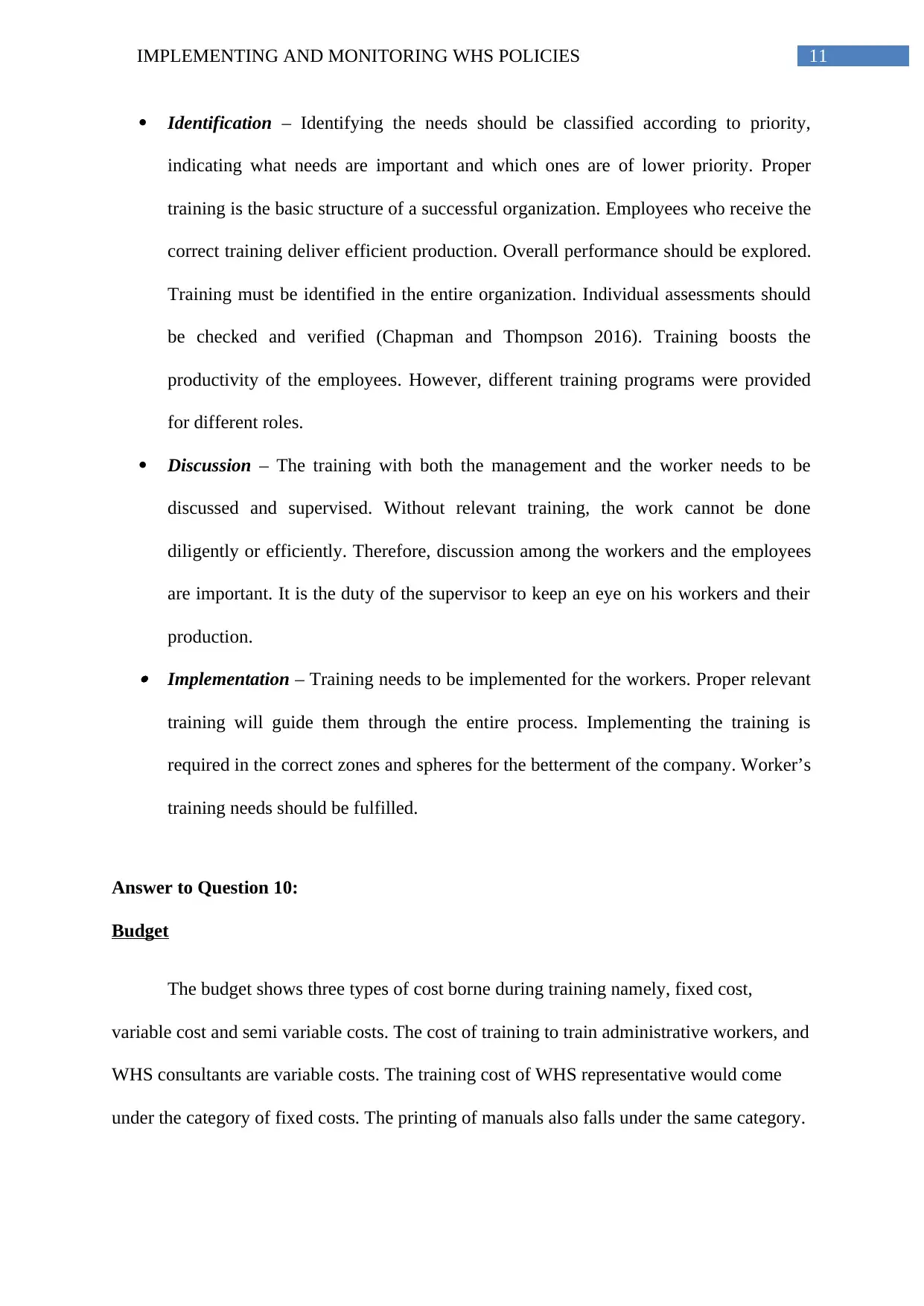
11IMPLEMENTING AND MONITORING WHS POLICIES
Identification – Identifying the needs should be classified according to priority,
indicating what needs are important and which ones are of lower priority. Proper
training is the basic structure of a successful organization. Employees who receive the
correct training deliver efficient production. Overall performance should be explored.
Training must be identified in the entire organization. Individual assessments should
be checked and verified (Chapman and Thompson 2016). Training boosts the
productivity of the employees. However, different training programs were provided
for different roles.
Discussion – The training with both the management and the worker needs to be
discussed and supervised. Without relevant training, the work cannot be done
diligently or efficiently. Therefore, discussion among the workers and the employees
are important. It is the duty of the supervisor to keep an eye on his workers and their
production. Implementation – Training needs to be implemented for the workers. Proper relevant
training will guide them through the entire process. Implementing the training is
required in the correct zones and spheres for the betterment of the company. Worker’s
training needs should be fulfilled.
Answer to Question 10:
Budget
The budget shows three types of cost borne during training namely, fixed cost,
variable cost and semi variable costs. The cost of training to train administrative workers, and
WHS consultants are variable costs. The training cost of WHS representative would come
under the category of fixed costs. The printing of manuals also falls under the same category.
Identification – Identifying the needs should be classified according to priority,
indicating what needs are important and which ones are of lower priority. Proper
training is the basic structure of a successful organization. Employees who receive the
correct training deliver efficient production. Overall performance should be explored.
Training must be identified in the entire organization. Individual assessments should
be checked and verified (Chapman and Thompson 2016). Training boosts the
productivity of the employees. However, different training programs were provided
for different roles.
Discussion – The training with both the management and the worker needs to be
discussed and supervised. Without relevant training, the work cannot be done
diligently or efficiently. Therefore, discussion among the workers and the employees
are important. It is the duty of the supervisor to keep an eye on his workers and their
production. Implementation – Training needs to be implemented for the workers. Proper relevant
training will guide them through the entire process. Implementing the training is
required in the correct zones and spheres for the betterment of the company. Worker’s
training needs should be fulfilled.
Answer to Question 10:
Budget
The budget shows three types of cost borne during training namely, fixed cost,
variable cost and semi variable costs. The cost of training to train administrative workers, and
WHS consultants are variable costs. The training cost of WHS representative would come
under the category of fixed costs. The printing of manuals also falls under the same category.
⊘ This is a preview!⊘
Do you want full access?
Subscribe today to unlock all pages.

Trusted by 1+ million students worldwide
1 out of 33
Related Documents
Your All-in-One AI-Powered Toolkit for Academic Success.
+13062052269
info@desklib.com
Available 24*7 on WhatsApp / Email
![[object Object]](/_next/static/media/star-bottom.7253800d.svg)
Unlock your academic potential
Copyright © 2020–2025 A2Z Services. All Rights Reserved. Developed and managed by ZUCOL.





